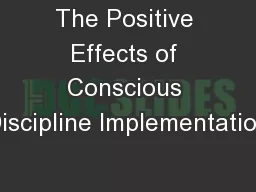

Presented by Jackie Smith ISD 191 Katie Keller ISD 191 Laurie Hume ISD 197 and Ann Siebenaler ISD 197 May 11th 2017 What is Conscious Discipline Conscious Discipline is a social emotional learning SEL program that aims to modify teacher and child behavior in order to create class ID: 606236
Download Presentation The PPT/PDF document "The Positive Effects of Conscious Discip..." is the property of its rightful owner. Permission is granted to download and print the materials on this web site for personal, non-commercial use only, and to display it on your personal computer provided you do not modify the materials and that you retain all copyright notices contained in the materials. By downloading content from our website, you accept the terms of this agreement.
Slide1
The Positive Effects of Conscious Discipline Implementation in ECSE
Presented by Jackie Smith (ISD 191), Katie Keller (ISD 191), Laurie Hume (ISD 197) and Ann Siebenaler (ISD 197)
May 11th, 2017Slide2
What is Conscious Discipline?
Conscious Discipline is a social emotional learning (SEL) program that aims to modify teacher and child behavior in order to create classrooms based on
safety
,
connection
, and
problem solving
instead of external rewards and punishments.Slide3
Conscious Discipline
Conscious discipline is based on current brain research, child development information, and developmentally appropriate practices. Conscious discipline has been specifically designed to make changes in the adults lives first.
Is a relationship-based program
It is not ...
• Punishment/reward-based
• Power/fear-based • Praise-focused • About fixing “bad” kids
problem
solving
connection
safetySlide4
What is Conscious Discipline?
Conscious Discipline’s goal is to create a system wide, relationship-based, community model for behavior management, called the “School Family.”Slide5
My School Family SongSlide6Slide7
Seven Skills of Conscious Discipline
Problem
Composure
Assertiveness
Encouragement
Choices
Empathy
Positive
Intent
ConsequencesSlide8
Evidence Based
Conscious Discipline is named in the
SAMHSA’s (Substance abuse and mental health administration) National Registry of Evidence-based Programs and Practices.Slide9
Implementation
Is an adult first model, requires support and ongoing progress monitoring
Is sustainable with internal champions
Is evidenced basedSlide10
Implementation Continued
The Conscious Discipline program is a
multiyear,
multicomponent,
school-based intervention that teaches administrators, teachers, and other staff the SEL skills to change the school culture, including discipline strategies and self-regulation skills for children, parents, and other adults.Slide11
Sustainable Implementation
•
Administrative buy in:
•
Conscious Discipline is part of the strategic plan
•Program wide structures•Team of teachers (and administrators) with additional CD training (CD 1 week long)•Ownership at the school level Slide12
Staff Buy-In
•
Conscious Discipline is an adult first model and cannot be forced onto staff.
•
Focus should be on those that are more interested and willing to use CD in their personal and professional life. Slide13
How We Started
Our Conscious Discipline journey-
2014-15 Anne Hoff certified trainer provided all staff training for the Early Learning Programs in Dakota County
Learned about the research behind Conscious Discipline
Brain state models
Focus on adult responsesSlide14
Internal Training and Support
•
Those teachers that are trained teach others.
•
Training for para -professionals and support staff.
•Outreach to parents and community (parent nights, community education). •Share info on CD with advisory committees in the district.Slide15
The Seven Powers of Conscious Discipline
Skill:
Composure
Power of Perception
Being the person you want others to become.
Smile T
ake a Deep Breath And R
elaxPower of Perception
No one can make you angry without your permission.
Slide16
S.T.A.R. programSlide17
S.T.A.R helperSlide18
Structures - Safe PlaceSlide19
Structure - Safe PlaceSlide20
Ritual - safe keeperSlide21
Structures - Friends and FamilySlide22
Skill: Assertiveness
The Power of Attention
What you focus on, you get more of.
Did you like it?
Go tell ________, “I don’t like it when you ________.Please ________. (Tell them what you’d like them to do instead.)Slide23
Routines in Pictures M.A.PSlide24
Routines & Transitions in picturesSlide25
Skill: Encouragement
Power of Unity
We are all in this together.
You ________ so that ________. That was helpful!Slide26
I Love You RitualsSlide27
Structure - kindness treeSlide28
Structures-JobsSlide29
Skill: Choices
The Power of Free Will
The only person you can “make” change is yourself.
You may ________ or ________. What’s best for you?Slide30
Structures - Picture RulesSlide31
Skill: Empathy
The Power of Acceptance
The moment is as it is.
You seem ________. Something must have happened.Slide32
We Care CenterSlide33
Skill: Positive Intent
The Power of Love
See the best in others.
You wanted ________. You may not ________. ________ hurts.
When you want ________ say or do ________.Slide34
Wish Well ProgramSlide35
Skill: Consequences
The Power of Intention
Mistakes are opportunities to learn.
You may ________ or ________. If you ________ again, you will ________. Tell me what will happen if you ________ again.Slide36
Time MachineSlide37
The positive effects of Conscious Discipline
Created a staff culture that we work together to help all students
Use of consistent language and visuals in all classrooms and learning areas (gym, motor room, cafeteria)
Students with behavior issues are staying in their classrooms longer and making progress using strategies
Students demonstrate empathy and an understanding of kindnessSlide38
Websites
https://consciousdiscipline.com/Slide39
Questions???
Thank you for participating today!